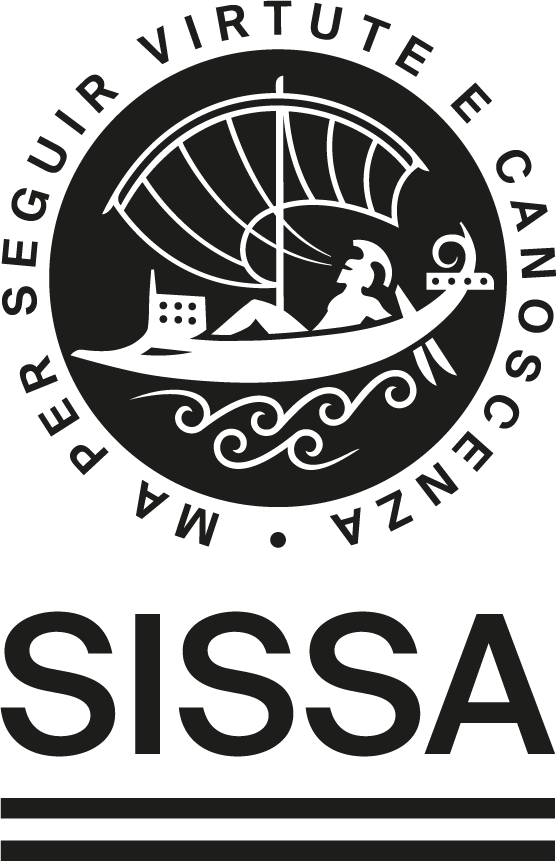Statistical Field Theory(TOLINK)
- Coupled XY models (contact: Andrea Trombettoni)
- Breaking of integrability in low-dimensional quantum systems (contact: Giuseppe Mussardo)
- Quantum quenches and boundary conformal field theories (contact: Giuseppe Mussardo)
- Numerical determination of mass spectrum of quantum field theories (contact: Giuseppe Mussardo)
Topological Quantum Information(TOLINK)
- Topological Quantum Computation (contact: Giuseppe Mussardo )
- Topological phases of matter and anyons (contact: Giuseppe Mussardo)
Complex and Disordered Quantum Systems(TOLINK)
- The superconductor-insulator transition in disordered systems: Properties of the Bose insulators (Bose glass); localization and entanglement in a system of disordered/interacting bosons; magnetic field driven transition, transport; many body localization in a bosonic systems.
(contact Markus Müller ) - Quantum glasses: development of new techniques and concepts to describe complex, frustrated quantum systems with a complicated energy landscape and therefore a complicated Hilbert space structure.
(contact Markus Müller )
Generalization of classical cavity method (on graphs) to quantum problems. Properties of the non-ergodic, glassy phase. Collective dynamics and nature of low energy excitations. (contact Markus Müller ) - Classical and quantum electron glasses: Avalanches, barriers and collective behavior in classical Coulomb glasses. Quantum glassy behavior in the vicinity of the metal-insulator transition. Analysis of many-body localization in strongly frustrated glasses.
(contact Markus Müller )
Other topics
- Universal percolative properties from field theory. Ref: G. Delfino, Field theory of Ising percolating clusters, Nucl.Phys.B818 (2009) 196 [hep-th arXiv:0902.3339]. (contact Gesualdo Delfino )
- We propose a study of many-body localization in spin systems and its connections with the performance of quantum algorithms. Is many-body localization really the analogous of a glass transition for decision problems?[1] (contact Antonello Scardicchio )
- Typical case complexity of QMA-complete decision problems [2]. From preliminary analyses of QMA-complete problems on random graphs, it appears that as the density of constraints is increased the system undergoes a series of phase transitions where the entanglement of the ground state increases before not some of the constraints start being violated. (contact Antonello Scardicchio )
- Does a PCP-like inapproximability theorem exist in quantum computing? What is its relation to the physics of glasses (both classical and quantum glasses)?[3] (contact Antonello Scardicchio )
- The best sphere packings in high dimensions: do disordered packings perform better than “regular” packings in high dimensions? Is it possible to use this conjecture to improve Minkowsky’s lower bound on the packing fraction?[4] (contact Antonello Scardicchio )
- Entanglement entropy: a) the properties of entanglement entropy of disconnected regions are not well understood yet not even for the simplest, 1-d critical spin chains. An analytic a study of these is needed.[5] b) Entanglement entropy and AdS/CFT duality. What is the origin of the duality proposed by Ryu and Takayanagi between entanglement entropy and the area of a d-dimensional surface in the bulk geometry? What is the origin and significance of the discontinuity found as two disconnected regions are moved away from each other?[6] (contact Antonello Scardicchio )
- Ads/CFT and strongly coupled condensed matter systems.[7] AdS/CFT is one of a handful of techniques which can deal with strongly coupled quantum systems. Recently it has been argued to be able to make non-trivial predictions on problems in the theory of condensed matter (mainly high-Tc superconductivity). This is an interesting line of research. (contact Antonello Scardicchio )
References:
- [1] Adiabatic quantum optimization fails for random instances of NP-complete problems, Boris Altshuler, Hari Krovi, Jeremie Roland, arixv:0908.2782
- [2] Statistical mechanics of classical and quantum computational complexity C. R. Laumann, R. Moessner, A. Scardicchio, S. L. Sondhi, arxiv:1009.1635
- [3] The PCP theorem by gap amplification Irit Dinur, Journal of the ACM (JACM) JACM, Volume 54 Issue 3, June 2007
- [4] Estimates of the optimal density and kissing number of sphere packings in high dimensions A. Scardicchio, F.H. Stillinger, S. Torquato, J. Math. Phys. 49, 043301 (2008)
- [5] Entanglement entropy of two disjoint intervals in conformal field theory II Pasquale Calabrese, John Cardy, Erik Tonni, J. Stat. Mech. (2011) P01021
- [6] Holographic Entanglement Entropy: An Overview Tatsuma Nishioka, Shinsei Ryu, Tadashi Takayanagi, J.Phys.A42:504008, (2009)
- [7] Holographic Superconductors Sean A. Hartnoll, Christopher P. Herzog, Gary T. Horowitz, JHEP0812:015,2008

